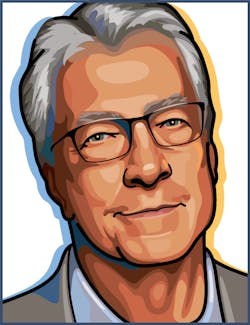
The COVID-19 shutdown of nonessential activities abruptly halted many of our most familiar professional interactions—the most visible and potentially enduring being the halt to physical tradeshows and technical conferences, and the embrace of virtual events.
Conferences and exhibitions run by SPIE and OSA took a sharp turn to the virtual shortly after SPIE Photonics West in February 2020, as the extent of the pandemic became clear. Kent Rochford, CEO of SPIE, told me, “Going virtual required choices. We’d considered live-streaming, but our attendance is international, and we knew time zones would create a barrier. But more importantly, we recognized that our community is not just researchers and engineers, but they are also parents who may now be caring for children at home, and employees whose jobs just became much more complicated.”
Rochford continued, “To mitigate the technology demands and time-zone requirements, we created an ‘asynchronous’ format that leveraged our Digital Library platform and the conference presentation recording initiative we started in 2017. We asked presenters to submit their presentation recordings ahead of the event and allowed participants to view and interact on their own schedule. We have held three of these Digital Forums in place of our Photonics Europe, Defense + Commercial Sensing, and Smart Structures + Nondestructive Evaluation events, and made these free of charge to help the community. And we were amazed at the number of authors who submitted material, and that over 8500 people registered.” In response to City of San Diego guidance, SPIE has just announced that its Optics + Photonics conference, scheduled for August, will transfer to a free Digital Forum.
Elizabeth Rogan, CEO of OSA, echoed Rochford’s comments following a very successful virtual co-sponsored CLEO in early May. “Our community encouraged us to run the virtual conference live, which resulted in almost 20,000 registrants from over 75 countries. The entire conference was presented live, and was highly interactive, with over 5500 Q&As. We had over 2000 presentations across 20 parallel sessions utilizing our Zoom platform, which had custom integrations with our meetings’ technologies to enable the experience. This was the third virtual conference we managed this year, so we were ready for the challenge.”
OSA anticipates that adding a virtual option to its future conferences will be essential. Frontiers in Optics, scheduled for September in Washington, DC, will be an all-virtual event. Rogan adds, “The OSA Board has been supportive of our inclusive approach of offering free access to non-presenters at all of our events in 2020. As we move forward with the virtual approach, we are focused on several challenges: How do we support the industry community providing a marketplace to connect buyers and sellers? How do we support our students, who need timely mentorship, hands-on experience, and encouragement to grow into their potential? How do we replace the valuable onsite networking in a virtual world?”
Is this shift to virtual just something to be endured while awaiting a return to “normal?” And will physical exhibitions return to generate the revenue needed to support large technical conferences? There are many sides to these issues and they often relate to timing: how are we responding now and what do we want for the future?
World economies are reopening as I write this in May, but could the lockdown resume in the fall with a new wave of infections? Will people want to meet and do business at a show while wearing a mask and social distancing? Will businesses be willing to bear the expense and risk of a booth and staff at a tradeshow?
Globally, event planners and exhibition halls—not to mention all the related hospitality, transportation, and service businesses—are hoping to find a path forward soon. Governments have a very large stake in tradeshows as engines of economic growth, and exhibition hall managers argue that tradeshows are not like a sports event or festivals and are much easier to control. Germany recently exempted exhibitions from rules barring mass gatherings. Subsequently, Messe München, which hosts LASER World of PHOTONICS, will hold trade fairs again beginning September 1, 2020. As for SPIE Photonics West in January 2021—it’s still on as scheduled, and SPIE, like OSA, is committed to providing a venue that will serve the community.
About the Author

Conard Holton
Conard Holton has 25 years of science and technology editing and writing experience. He was formerly a staff member and consultant for government agencies such as the New York State Energy Research and Development Authority and the International Atomic Energy Agency, and engineering companies such as Bechtel. He joined Laser Focus World in 1997 as senior editor, becoming editor in chief of WDM Solutions, which he founded in 1999. In 2003 he joined Vision Systems Design as editor in chief, while continuing as contributing editor at Laser Focus World. Conard became editor in chief of Laser Focus World in August 2011, a role in which he served through August 2018. He then served as Editor at Large for Laser Focus World and Co-Chair of the Lasers & Photonics Marketplace Seminar from August 2018 through January 2022. He received his B.A. from the University of Pennsylvania, with additional studies at the Colorado School of Mines and Medill School of Journalism at Northwestern University.